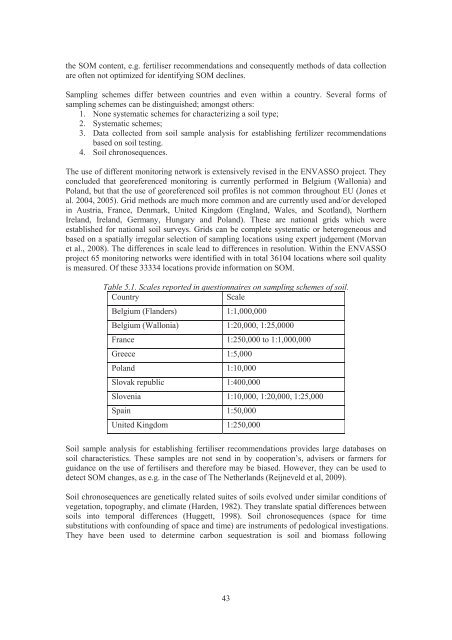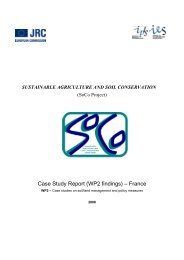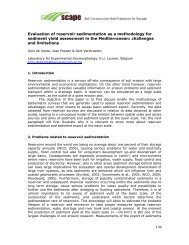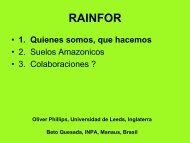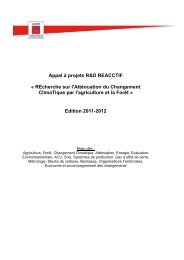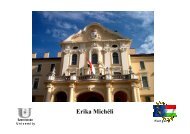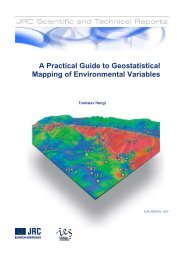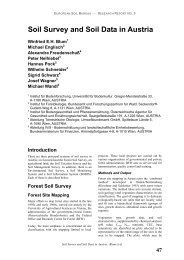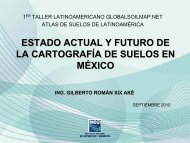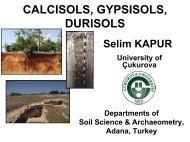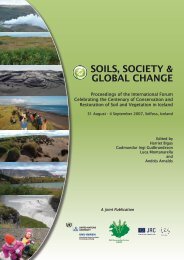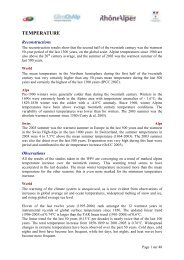Risk Assessment Methodologies of Soil Threats in Europe
Risk Assessment Methodologies of Soil Threats in Europe
Risk Assessment Methodologies of Soil Threats in Europe
You also want an ePaper? Increase the reach of your titles
YUMPU automatically turns print PDFs into web optimized ePapers that Google loves.
the SOM content, e.g. fertiliser recommendations and consequently methods <strong>of</strong> data collection<br />
are <strong>of</strong>ten not optimized for identify<strong>in</strong>g SOM decl<strong>in</strong>es.<br />
Sampl<strong>in</strong>g schemes differ between countries and even with<strong>in</strong> a country. Several forms <strong>of</strong><br />
sampl<strong>in</strong>g schemes can be dist<strong>in</strong>guished; amongst others:<br />
1. None systematic schemes for characteriz<strong>in</strong>g a soil type;<br />
2. Systematic schemes;<br />
3. Data collected from soil sample analysis for establish<strong>in</strong>g fertilizer recommendations<br />
based on soil test<strong>in</strong>g.<br />
4. <strong>Soil</strong> chronosequences.<br />
The use <strong>of</strong> different monitor<strong>in</strong>g network is extensively revised <strong>in</strong> the ENVASSO project. They<br />
concluded that georeferenced monitor<strong>in</strong>g is currently performed <strong>in</strong> Belgium (Wallonia) and<br />
Poland, but that the use <strong>of</strong> georeferenced soil pr<strong>of</strong>iles is not common throughout EU (Jones et<br />
al. 2004, 2005). Grid methods are much more common and are currently used and/or developed<br />
<strong>in</strong> Austria, France, Denmark, United K<strong>in</strong>gdom (England, Wales, and Scotland), Northern<br />
Ireland, Ireland, Germany, Hungary and Poland). These are national grids which were<br />
established for national soil surveys. Grids can be complete systematic or heterogeneous and<br />
based on a spatially irregular selection <strong>of</strong> sampl<strong>in</strong>g locations us<strong>in</strong>g expert judgement (Morvan<br />
et al., 2008). The differences <strong>in</strong> scale lead to differences <strong>in</strong> resolution. With<strong>in</strong> the ENVASSO<br />
project 65 monitor<strong>in</strong>g networks were identified with <strong>in</strong> total 36104 locations where soil quality<br />
is measured. Of these 33334 locations provide <strong>in</strong>formation on SOM.<br />
Table 5.1. Scales reported <strong>in</strong> questionnaires on sampl<strong>in</strong>g schemes <strong>of</strong> soil.<br />
Country Scale<br />
Belgium (Flanders) 1:1,000,000<br />
Belgium (Wallonia) 1:20,000, 1:25,0000<br />
France 1:250,000 to 1:1,000,000<br />
Greece 1:5,000<br />
Poland 1:10,000<br />
Slovak republic 1:400,000<br />
Slovenia 1:10,000, 1:20,000, 1:25,000<br />
Spa<strong>in</strong> 1:50,000<br />
United K<strong>in</strong>gdom 1:250,000<br />
<strong>Soil</strong> sample analysis for establish<strong>in</strong>g fertiliser recommendations provides large databases on<br />
soil characteristics. These samples are not send <strong>in</strong> by cooperation’s, advisers or farmers for<br />
guidance on the use <strong>of</strong> fertilisers and therefore may be biased. However, they can be used to<br />
detect SOM changes, as e.g. <strong>in</strong> the case <strong>of</strong> The Netherlands (Reijneveld et al, 2009).<br />
<strong>Soil</strong> chronosequences are genetically related suites <strong>of</strong> soils evolved under similar conditions <strong>of</strong><br />
vegetation, topography, and climate (Harden, 1982). They translate spatial differences between<br />
soils <strong>in</strong>to temporal differences (Huggett, 1998). <strong>Soil</strong> chronosequences (space for time<br />
substitutions with confound<strong>in</strong>g <strong>of</strong> space and time) are <strong>in</strong>struments <strong>of</strong> pedological <strong>in</strong>vestigations.<br />
They have been used to determ<strong>in</strong>e carbon sequestration is soil and biomass follow<strong>in</strong>g<br />
43


